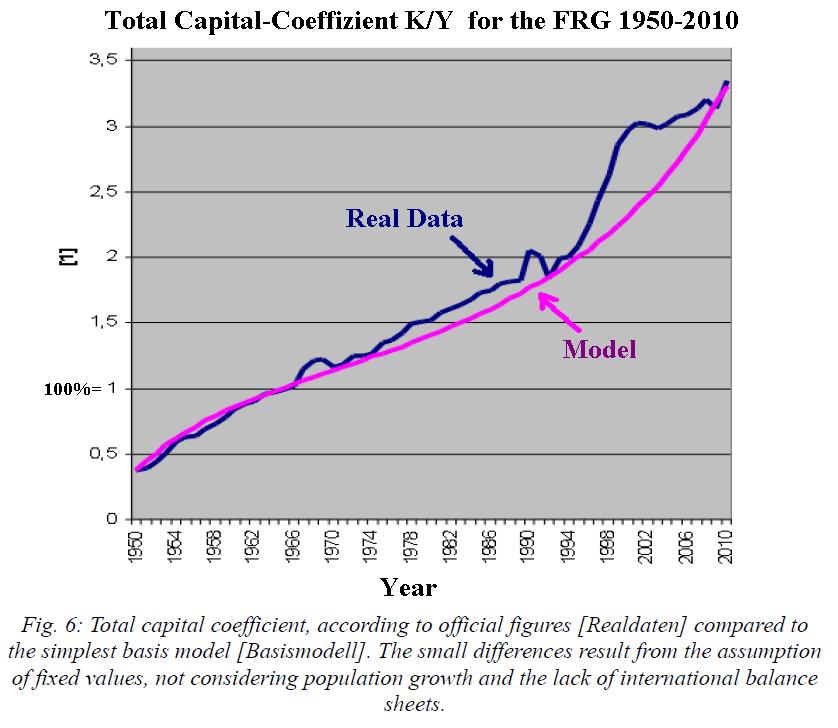10 Capital Coefficients in the Model and Reality
The integrated values of Y and K, as well as the real values can be summarized conveniently in the total capital coefficient K/Y (fig. 6). Because the economic effectiveness is always given by this, as inflation is always shortened out due to the fact that both GDP and the capital stock are measured in units of currency. Currency is purely nominal, and the value of the currency is not determined by the nominal, but by what one could buy22 with it.

But what we have not considered in the basis model in detail, is the impact of inflation on the nominal monetary expression of Y and K in units of currency. In the model, we always compute Y and K in units of points, we always start with
![]() (10.1)
(10.1)
and by the initial value![]() , which can be
extracted from the real numbers determined of the Federal Republic
in 1950, and was indeed
, which can be
extracted from the real numbers determined of the Federal Republic
in 1950, and was indeed
![]() (10.2).
(10.2).
Currency points and currency units differ only
by a conversion factor. The inflation would be without inflation (![]() ) be constant
over time. But since we always have inflation, and as we will see later, this
is an intrinsic symmetry principle and predictable effect of the economy, this
conversion factor is variable in time. Inflation is no interest in the proper
sense because it has on capital and GDP, which are measured both in units of
capital (currency), exactly the same effect. So inflation creates no relative
gain or loss. This only makes
) be constant
over time. But since we always have inflation, and as we will see later, this
is an intrinsic symmetry principle and predictable effect of the economy, this
conversion factor is variable in time. Inflation is no interest in the proper
sense because it has on capital and GDP, which are measured both in units of
capital (currency), exactly the same effect. So inflation creates no relative
gain or loss. This only makes ![]() .
Therefore, the currency values of the individual functions Y and K
need a correction factor which includes the effect of inflation23. How to make these handy conversion
will be explained now. In the illustration of the basic model calculation is
has already been carried out in a linear fashion, so that instead of points the
solution appears in units of the currency Euro. If one wants to calculate an inflation
adjustment from the official empirical data one needs to bear in mind however,
that these offical values are calculated by a variety of different specific
group of buyers and their temporally variable commodity baskets, and thus are
only approximately calculated. From the 1980s, this statistical figure is also
increasingly bent by hedonic methods24. The
time-varying baskets
.
Therefore, the currency values of the individual functions Y and K
need a correction factor which includes the effect of inflation23. How to make these handy conversion
will be explained now. In the illustration of the basic model calculation is
has already been carried out in a linear fashion, so that instead of points the
solution appears in units of the currency Euro. If one wants to calculate an inflation
adjustment from the official empirical data one needs to bear in mind however,
that these offical values are calculated by a variety of different specific
group of buyers and their temporally variable commodity baskets, and thus are
only approximately calculated. From the 1980s, this statistical figure is also
increasingly bent by hedonic methods24. The
time-varying baskets ![]() can be described mathematically as
can be described mathematically as
![]() (10.3).
(10.3).
That means the price of the i-th
commodity basket of shopping for the consumer group i (eg average income
people, entrepreneurs, industries, etc.) is the weighted product price from the
sum over all products j. Their proportions![]() however, vary according to consumer group, between 0 and 1. In addition
there is a factor
however, vary according to consumer group, between 0 and 1. In addition
there is a factor ![]() from hedonic method. This means that assumed product
quality improvements will be adopted with a “better” price
from hedonic method. This means that assumed product
quality improvements will be adopted with a “better” price ![]() in effect reducing inflation. All factors are variable in time and the
choice is not given here by clear rules. The relevant for the consumer group i
calculated inflation rate is then the temporal change in the price of the i-th
commodity basket, so:
in effect reducing inflation. All factors are variable in time and the
choice is not given here by clear rules. The relevant for the consumer group i
calculated inflation rate is then the temporal change in the price of the i-th
commodity basket, so:
![]() (10.4).
(10.4).
The importance of the capital coefficient is so great because it establishes the proportion between in the principle value-free money to the valuable tradable goods and services. It is also free from the effects of inflation explained, because both the capital and the GDP calculated in units of capital and thus includes the only approximately known effect of inflation in exact the same way. The graphical representation of the total capital coefficient thus offers the easiest and fastest way of comparison between real economic data, both for the comparisons with other nations, and of course against the various model calculations.